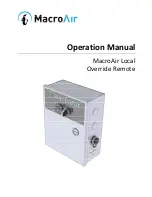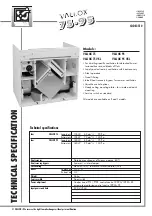
Twin City Fan & Blower Installation and Maintenance Manual: IM-495
5
Maintenance of Fans
This section contains general maintenance instructions for your
Twin City Fan & Blower unit. For specific information about
maintenance of components, particularly for special application
fans, see the attached documents.
General Motor Maintenance
The three basic rules of motor maintenance are keep the motor
clean, dry and properly lubricated.
Keeping motors and windings clean is important because dirt and
dust serve as thermal insulators. Heat normally dissipated by the
motor is trapped causing overheating and/or premature failure.
Blow dust and dirt out of windings and off the motor periodically.
Use low pressure (50 psig) airstream so that winding damage does
not occur. Keep the area surrounding the motor open so the air can
circulate through the motor cooling fan. Follow normal maintenance
schedule given to the right.
Motors should be kept dry to avoid electrical short circuits. Motors
kept in storage for long periods of time can have moisture condense
on the windings. Be certain the motor is dry before using.
Some smaller motors are lubricated for life. Motor bearing
lubrication, if required, must follow a rigorous schedule. Motors
less than 10 hp running about eight hours a day in a clean
environment should be lubricated once every five years; motors
15 to 50 hp, every 3 years; and motors 50 to 150 hp, yearly. For
motors in a dusty or dirty environment or running 24 hours a
day, divide the service interval by 2. If the environment is very
dirty or high temperatures exist, divide the service interval by 4.
Lubrication requirements are normally attached to the motor. Do
not overlubricate.
Impeller and Shaft Maintenance
Periodically inspect the shaft and impeller for dirt buildup, corrosion
and signs of excess stress or fatigue. Clean the components and,
when appropriate, apply new coatings. (Any addition of coatings or
weld can create an imbalance.) Check the balance of the assembly.
Structural Maintenance
All structural components or devices used to support or attach the
fan to a structure should be checked at regular intervals. Vibration
isolators, bolts, foundations, etc., are subject to failure from
corrosion, erosion and other causes. Improper mounting can lead
to poor operation characteristics or fan fatigue and failure.
Check metallic components for corrosion, cracks or other signs
of stress. Concrete should be checked to ensure the structural
integrity of the foundation.
Troubleshooting Guidelines
Use current safety practices when investigating fan or system
performance problems. General safe practices and performance
troubleshooting guidelines can be found in AMCA Publications
410 and 202, respectively. Fan application and field measurement
procedures can be found in AMCA Publications 201 and 203.
Troubleshooting Performance
Problems
The lists below indicate possible areas to check when air or sound values
do not match expectations. Most fan problems can be pinpointed to
one of these common causes.
Air Capacity Problems:
1. Resistance of system not at design rating. If resistance is lower
than expected, both airflow and horsepower may be up. If
resistance is higher than anticipated, air volume will be down.
2. Fan speed is not at design speed.
3. Air density not at design values. Also check air performance
measurement techniques/procedures.
4. Devices for air modulation are closed or plugged. Also check
filters.
5. Impeller mounted improperly or is rotating in reverse.
6. Parts of system or fan have been damaged or need cleaning.
Noise Problems:
1. Air performance is incorrect and fan is not at design point of
operation. Fan forced to operate in an unstable flow region.
2. Bearing failure. Check bearings (lubrication).
3. Supply voltage high or inconsistent supply frequency. Adjustable
frequency controllers can generate motor noise.
4. Objects that are installed in a high velocity airstream can
generate noise. This includes flow sensors, turning vanes, etc.
5. Poor fan inlet conditions.
6. Acoustics or sound measurement procedure incorrect.
Vibration Problems:
1. Misalignment of drive components.
2. Poor foundations or mounting structure (resonances).
3. Foreign material attached to rotating components.
4. Damaged rotating components (bearings, shaft, fan, impeller).
5. Broken, loose or missing set screws.
6. Loose bolts.
7. Vibration transmitted by another source.
8. Water accumulating in airfoil blades.
9. Fan is operating in stall or unstable flow region.
All fans manufactured by Twin City Fan & Blower are factory
balanced prior to shipment. Installation variables, handling and
movement of the fan during shipment may cause the rotating
assembly to shift. Balance should be checked once the fan is
installed. If a final trim balance is required, it is the end user's
responsibility to bring the fan back to factory specifications. Final
trim balancing is not the responsibility of Twin City Fan & Blower.
NOTICE


























